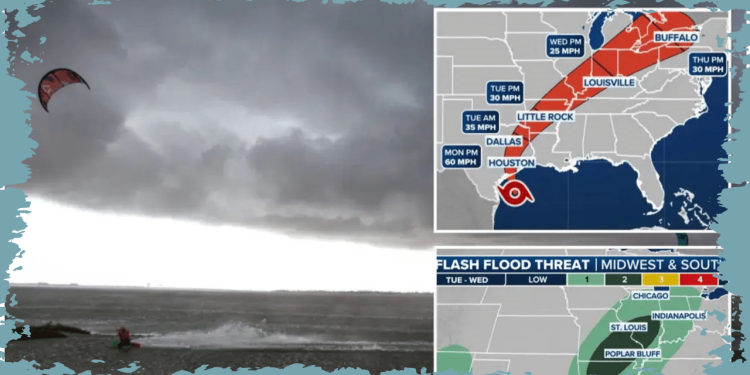As Hurricane Beryl approaches Texas, the cyclone is likely to bring in hurricane-like conditions on Monday. However, the Midwest region will not be spared from its impact as strong winds and heavy rainfall are expected to move in by midweek.
Beryl’s effects will be felt by several states, including Michigan, Indiana, Illinois, and Ohio.
The anticipated path of Beryl is projected to take it through Texas, with the cyclone then heading northward across the South and Midwest regions.
According to recent reports, Tropical Storm Beryl is predicted to hit Texas south of Houston with hurricane strength, which could potentially result in tornadoes and floods.
According to the latest forecast cone from Beryl, the storm is expected to weaken as it moves north. However, it is still anticipated to maintain its tropical depression strength from Arkansas through Michigan for the remainder of the week.
When a cyclone has maximum sustained winds that do not exceed 38 mph, it is classified as a tropical depression.
Tropical depressions are distinguished by numbers instead of names, unlike tropical storms and hurricanes.
By the end of the workweek, the remnants of Beryl are expected to reach Ohio and Michigan, according to current forecasts.
Texas is bracing for impact as Beryl is expected to make landfall as a hurricane once again. The storm is currently churning towards the state, with forecasts predicting its arrival in the coming days. Texans are being urged to take precautions and prepare for potential impacts from the storm.
The storm’s northward movement could result in several inches of rainfall, which may lead to significant concerns of flash flooding.
Midweek is expected to bring heavy rainfall, spreading from eastern Texas to central Illinois, according to forecasters.
On Sunday, the Weather Prediction Center stated that the focus of higher precipitation amounts is currently towards central Illinois and northwest Arkansas, with the Ozarks region experiencing the highest amounts. It is expected that the areal averages will range from 2 to 5 inches, with certain areas seeing local maximums of up to 8 inches.
On June 29, the Atlantic Ocean saw the emergence of Beryl, which quickly escalated into the first hurricane of the season.
As it makes its way towards Texas, the storm has already broken several records and is projected to intensify further.
Read More: Local Little League president claims pressure to remove undefeated team, calls for investigation


